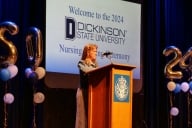You have /5 articles left.
Sign up for a free account or log in.
ORLANDO, Fla. -- Some Ohio community colleges have found that adding a personal touch to email messages and other correspondence sent to students has helped increase attendance in summer courses.
The colleges are part of an ongoing study project to encourage students to take summer courses in the hopes of helping them complete college. The Encouraging Additional Summer Enrollment, or EASE, study is being conducted by MDRC, a nonpartisan, nonprofit social policy research organization, which released its findings this month and presented them Monday during the American Association of Community Colleges' 99th annual convention in Orlando.
The study, which is being conducted at 10 community colleges in Ohio, has so far found that personalizing the wording in emails and letters to students about their financial aid had positive results. Those students were more likely to enroll in summer courses. And more students enrolled in summer courses after they received the personalized emails and letters from their colleges along with tuition assistance to cover the gap between their existing financial aid and the cost of summer attendance.
The study found 31.5 percent of students enrolled in summer courses in 2017 and 2018 when they received personalized emails and letters. Only 26.2 percent of students enrolled in summer courses with generic information. Those students who received the revised messages and tuition assistance enrolled at an even higher rate -- 38.4 percent.
“We know from previous MDRC research that students who enroll in summer courses are more likely to persist,” said Camielle Headlam, the EASE project manager and a research analyst at MDRC. “One barrier we found is that financial aid for summer courses is complex.”
She said students may not understand that they have financial aid available for summer classes because financial aid award letters are lengthy and confusing, or they may be discouraged by additional forms they have to complete to enroll in summer courses.
Some of the colleges in the study altered written communications with students by directly referring to the student by name or including relevant personal details, such as the amount of aid money they had available to attend summer classes. The messages also include contact information and the name of an adviser the student can contact, which were details that hadn't been used before.
“We used to say ‘Dear student’ or not even that,” said Bob Haas, chief strategy officer for Marion Technical College. “Now everything has a student’s name. It’s personalized.”
Marion Tech, one of the 10 colleges in the study, also includes specific course recommendations to students that will help them complete academic requirements for their major so they can graduate.
“It’s labor intensive and there’s no real way to automate it,” Haas said. “It takes a little work, but we are doing it.”
Haas said the college worked with MDRC to also craft the timing of the messages so they aren't sent on Fridays or holidays.
According to MDRC research, 80 percent of the community college students had leftover aid from their federal Pell Grants that could have been used to pay for summer courses. But only 20 percent of community college students enroll in summer classes. Students may have misinterpreted or overlooked information about their summer aid, or they may have thought they used all their available aid, according to an MDRC report.
Many colleges have seen enrollment increase in their summer courses since Congress agreed to restore year-round Pell Grants in 2017. The MDRC study took place in 2017 before the return of year-round Pell and in 2018 after it was reinstated.
Headlam said the colleges saw enrollment increases prior to and after the restoration of year-round Pell, an indication that the personalized messaging based on behavioral science does play a role in increasing student summer attendance.
However, the researchers didn’t see any changes or effects on fall semester re-enrollment, which remained flat at 55.8 percent across all 10 colleges.
"We were a little disappointed by this, but we would have to get many more students to enroll in summer courses to see an impact on fall re-enrollment," Headlam said.








